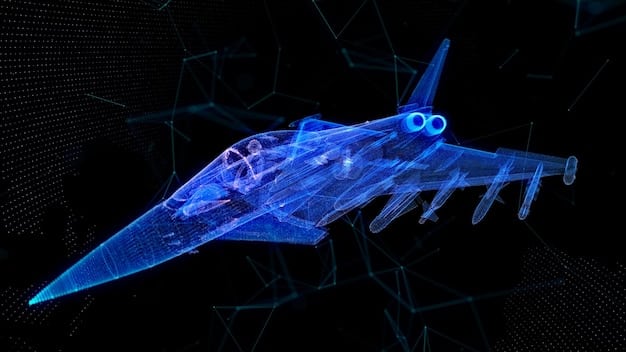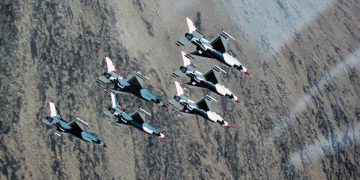The Future of Military Aviation: Analyzing the Air Force’s Next-Gen Fighter Program

The Future of Military Aviation: Analyzing the Air Force’s Next-Generation Fighter Program explores the advanced technologies, evolving strategies, and critical challenges shaping the future of aerial warfare, focusing on the U.S. Air Force’s pursuit of a dominant next-generation fighter.
The rapidly changing landscape of global security demands constant innovation in military technology. The **Future of Military Aviation: Analyzing the Air Force’s Next-Generation Fighter Program** is at the forefront of this innovation, poised to redefine aerial combat and national defense strategies.
Understanding the Next-Generation Fighter Program
The U.S. Air Force’s Next-Generation Fighter Program represents a significant leap forward in military aviation. This initiative aims to develop and deploy a fighter aircraft capable of surpassing current and near-future adversary technologies, ensuring air superiority in contested environments.
The program’s ambition extends beyond simply improving existing fighter designs. It seeks to integrate a suite of revolutionary capabilities, including advanced sensors, stealth technologies, cyber resilience, and sophisticated networking functionalities, which will enable these fighters to operate effectively in complex, multi-domain battlefields.
Key Objectives of the Program
The Next-Generation Fighter Program is driven by several critical objectives that reflect the evolving challenges facing the U.S. Air Force.
- Maintaining Air Superiority: Ensuring that the U.S. Air Force retains its ability to dominate the skies against any potential adversary.
- Technological Advancement: Integrating cutting-edge technologies to provide a decisive advantage in aerial combat.
- Adaptability: Designing a fighter that can adapt to rapidly changing threats and technological advancements.
- Interoperability: Ensuring seamless integration with other military assets and allied forces.
The successful execution of this program is crucial for maintaining the U.S.’s strategic advantage in the face of increasingly sophisticated global threats.
Advanced Technologies Shaping the Future
The Next-Generation Fighter Program is built upon a foundation of advanced technologies that will define the future of aerial warfare. These innovations are designed to provide a decisive edge in both offensive and defensive capabilities, ensuring that the new fighter can effectively counter emerging threats.
Several key technological areas are driving the development of these next-generation fighters. Among them are advanced stealth technologies, enhanced sensors and data processing systems, and innovative propulsion systems, all of which are critical to achieving superior performance and survivability.

Stealth Technology and Cyber Resilience
Stealth technology remains a cornerstone of next-generation fighter design, significantly reducing an aircraft’s visibility to radar and other detection systems. However, the program is also focused on improving cyber resilience to protect against sophisticated electronic warfare and hacking attempts.
Next-generation stealth integrates advanced materials and aerodynamic designs to minimize radar cross-section. This is complemented by robust cybersecurity measures to protect the fighter’s critical systems from cyberattacks. The combination of physical stealth and digital protection ensures a fighter that is both hard to detect and highly resistant to electronic interference.
The Strategic Importance of Air Superiority
Air superiority remains a critical component of modern military strategy. Maintaining control of the skies allows for the effective deployment of ground and naval forces, provides crucial intelligence gathering capabilities, and enables rapid response to emerging threats.
The Next-Generation Fighter Program is essential to ensuring that the U.S. Air Force maintains its air superiority in the face of evolving global threats. By developing a fighter that can outmatch current and future adversaries, the program aims to deter potential conflicts and protect national security interests.
Impact on Global Power Dynamics
The development and deployment of next-generation fighters can significantly impact global power dynamics. This advanced technology not only enhances the U.S.’s military capabilities but also signals its commitment to maintaining a strategic advantage over potential adversaries.
- Deterrence: Advanced fighters can deter potential adversaries by demonstrating a clear technological advantage.
- Alliances: The program can strengthen alliances by providing advanced defense capabilities to partner nations.
- Influence: Maintaining air superiority enhances the U.S.’s influence in international affairs.
The Next-Generation Fighter Program is therefore not just a military endeavor but also a tool for shaping global security and maintaining a balance of power.
Developing this technology and integrating them into existing military strategy. This advanced capabilities will be the core.
Challenges and Obstacles in Development
The development of next-generation fighters is fraught with technical, financial, and logistical challenges. Overcoming these obstacles requires innovative approaches, strategic planning, and strong collaboration between government, industry, and research institutions.
One of the primary challenges is the high cost associated with developing and deploying these advanced technologies. Next-generation fighters involve significant investments in R&D, prototyping, testing, and manufacturing, making cost management a critical concern.

Managing Costs and Timelines
Effective cost management and adherence to timelines are essential for the success of the Next-Generation Fighter Program. Delays and budget overruns can undermine the program’s strategic objectives and create opportunities for adversaries to catch up.
To address these challenges, the Air Force is implementing rigorous project management practices, including regular reviews, risk assessments, and performance metrics. These measures help ensure that the program stays on track and within budget, maximizing the return on investment.
International Competition and Cooperation
The Next-Generation Fighter Program is not operating in a vacuum. Several countries around the world are also developing their own advanced fighter technologies, creating both competition and opportunities for cooperation.
Countries like Russia, China, and the United Kingdom are investing heavily in next-generation fighter programs, each with its own unique strengths and capabilities. These programs pose a potential challenge to U.S. air superiority and underscore the importance of maintaining a technological edge.
Potential for Collaboration
While competition is inevitable, there are also opportunities for international cooperation in areas such as research and development, technology sharing, and joint training exercises. Collaborating with allied nations can help reduce costs, share expertise, and enhance interoperability.
- Joint R&D: Collaborating on research and development projects can accelerate technological advancements and reduce costs.
- Technology Sharing: Sharing advanced technologies can enhance the capabilities of allied forces.
- Joint Training: Conducting joint training exercises can improve interoperability and foster stronger partnerships.
Strategic alliances and partnerships can play a crucial role in ensuring that the Next-Generation Fighter Program remains competitive and effective in a global context.
Such coorporation may result in future project development.
The Human Element: Pilots and Training
While advanced technology is crucial, the human element remains a critical factor in the success of the Next-Generation Fighter Program. The skills, training, and adaptability of pilots are essential to maximizing the potential of these advanced aircraft.
Next-generation fighters require pilots who are not only skilled aviators but also adept at managing complex data systems, coordinating with other military assets, and making split-second decisions in high-pressure situations. The training programs for these pilots must therefore be comprehensive and rigorous.
Pilots need skills that will take to new levels of training and execution.
Evolving Training Programs
To prepare pilots for the challenges of flying next-generation fighters, training programs are evolving to incorporate advanced simulation technologies, virtual reality environments, and data-driven instruction. These programs aim to provide pilots with realistic and immersive training experiences that prepare them for a wide range of operational scenarios.
The Next-Generation Fighter Program will succeed, if the technologies are well developed.
| Key Point | Brief Description |
|---|---|
| 🚀 Advanced Technologies | Integration of stealth, sensors, and propulsion systems for enhanced combat capabilities. |
| 🌐 Strategic Air Superiority | Maintaining dominance in the skies for effective ground and naval force deployment. |
| 💰 Development Challenges | Cost management, timeline adherence, and technological obstacles in development. |
| ✈️ Pilot Training | Comprehensive training programs to prepare pilots for advanced aircraft systems. |
FAQ
▼
The primary goal is to develop and deploy a fighter aircraft that surpasses current and future adversary technologies, ensuring U.S. air superiority in contested environments. This involves integrating advanced features and innovative capabilities.
▼
Key technologies include advanced stealth capabilities to reduce radar visibility, enhanced sensors for improved situational awareness, cyber resilience to protect against electronic warfare, and innovative propulsion systems for increased performance.
▼
Air superiority allows for the effective deployment of ground and naval forces, provides critical intelligence gathering capabilities, and enables rapid response to emerging threats. It is essential for deterring potential conflicts and protecting national security interests.
▼
Challenges include high development costs, managing timelines, overcoming technological obstacles, and maintaining cost-effectiveness. Effective project management and collaboration between government, industry, and research institutions are crucial.
▼
Pilot training programs involve advanced simulation technologies, virtual reality environments, and data-driven instruction. These programs aim to provide realistic and immersive experiences, preparing them for the complex demands of operating advanced aircraft.
Conclusion
The Next-Generation Fighter Program represents a critical investment in the future of military aviation. By embracing advanced technologies and adapting to evolving threats, the U.S. Air Force aims to maintain its strategic advantage and ensure national security in an increasingly complex global landscape.





